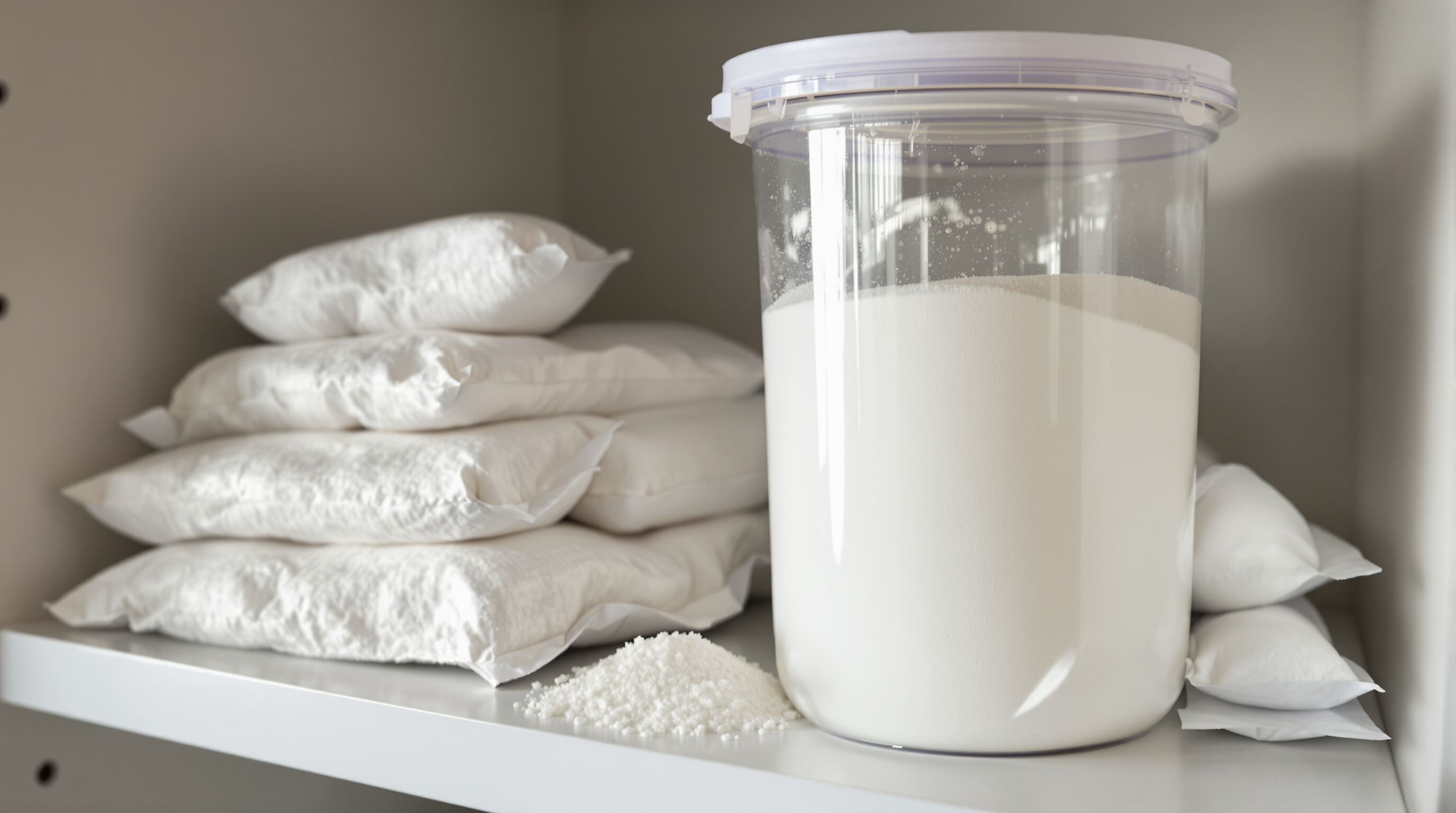Understanding the Composition of Washing Powder and Its Storage Needs
What Makes Up Powder Detergent and Why It Matters for Storage
Washing powders today are made up of several key ingredients including surfactants, enzymes, bleaching agents, and pH regulators. Each of these components needs certain storage conditions to work properly. For instance, surfactants which make up around 15 to 30 percent of most formulas tend to become runny when they get damp. Then there's sodium carbonate, something often added to adjust pH levels, that actually turns rock solid like concrete when humidity goes above 60%. This explains why so many people end up with ineffective detergent. A recent study from the American Cleaning Institute found that out of all the degraded samples they tested in 2023, an impressive 83% had been stored incorrectly somehow.
The Role of Enzymes and Surfactants in Washing Powder Stability
The enzymes protease and amylase, which help break down those pesky organic stains, start losing their effectiveness once temps hit around 86 degrees Fahrenheit or 30 Celsius. At the same time, certain cleaning agents called nonionic surfactants, including things like alcohol ethoxylates, tend to break down about 40 percent quicker if kept close to ozone generators. Washing machines are actually one common source of ozone in homes. A study published by researchers at Kansas State University back in 2022 looked into this exact issue with textiles. Because these two factors work together against effective cleaning products, it really pays off to store them somewhere cool and dry, preferably not right next to any laundry equipment where ozone might be present.
How Moisture Affects the Chemical Integrity of Washing Powder
When moisture gets into detergents, it starts breaking down their chemical makeup through a process called hydrolysis. Research published in the Journal of Applied Chemistry back in 2022 found something pretty interesting about this. Even when detergents are exposed briefly to around 55% humidity levels, they lose between 18 to 22% of their ability to remove stains over the course of three months. The cellulose materials used as anti-redeposition agents actually soak up surrounding moisture, which creates little pockets where oxygen bleach stops working properly. Sealing containers correctly makes all the difference though. Products stored this way keep about 94% of their original cleaning strength after a whole year, while those left in open cardboard boxes drop down to only 67% effectiveness. That's quite a gap.
Optimal Storage Conditions to Preserve Washing Powder Quality

Proper storage protects the chemical balance of washing powder while maintaining cleaning performance. Follow these evidence-based guidelines to ensure your detergent retains efficacy from first use to final scoop.
Maintaining Dry Environments to Prevent Clumping in Washing Powder
Moisture absorption is the primary cause of clumping, reducing flowability and dosing accuracy. Store washing powder in areas with <65% relative humidity, as higher levels trigger moisture uptake within 8 hours (Household Chemical Safety Institute 2023). Including silica gel packs in storage containers can extend dry conditions by 30% compared to uncontrolled environments.
Temperature Considerations for Effective Long-Term Storage
| Storage Condition | Optimal Range | Performance Impact Beyond Range |
|---|---|---|
| Temperature | 15–25°C (59–77°F) | Enzyme deactivation above 30°C (86°F) |
| Thermal Fluctuations | <5°C variation | Accelerated surfactant degradation |
Maintain stable conditions—research shows temperature swings reduce detergent efficacy 18% faster than constant warm storage.
Using Airtight Containers to Extend Washing Powder Shelf Life
Transfer powder immediately to containers with:
- Silicone-gasket sealed lids
- UV-protected materials
- Wide-mouth designs preventing residue buildup
Laboratory tests demonstrate airtight storage preserves 94% of original cleaning power after 12 months versus 67% in opened cardboard boxes.
Avoiding Direct Sunlight and High-Humidity Areas Like Bathrooms
UV exposure breaks down optical brighteners 40% faster, while bathroom humidity typically exceeds 80%—triple the recommended threshold. Alternative locations like bedroom closets maintain 72% lower environmental moisture on average.
Common Mistakes That Compromise Washing Powder Effectiveness
Leaving Washing Powder in Original Cardboard Boxes Exposed to Air
Most people just leave their laundry detergent in those cardboard boxes from the store, not realizing how much it affects effectiveness over time. The cardboard itself isn't really sealed properly, so air gets in along with humidity which starts breaking down what makes the detergent work. Research published around 2022 looked at how different storage methods impact performance. They discovered that when kept in cardboard versus something tightly closed, the cleaning power drops by about 12% after only three months. That means those half-used boxes sitting in the laundry room might actually be doing less than expected when it comes to getting clothes clean.
Storing Near Washing Machines or Sinks Increases Moisture Risk
Placing washing powder near appliances or plumbing fixtures exposes it to consistent humidity. Detergent powders absorb moisture at a rate of 3–5% per week in environments with >60% humidity (Laundry Science Journal, 2023), leading to hardening clumps that reduce solubility. This moisture also deactivates oxygen-based bleaching agents critical for stain removal.
Contamination From Wet Scoops or Shared Dispensing Containers
Using damp measuring tools introduces water directly into the powder, causing localized clumping and microbial growth. Shared containers compound this issue through cross-contamination—tests show multi-user systems have 4× higher moisture content than single-household containers. Always use completely dry scoops and dedicate containers to individual products.
Maximizing Shelf Life and Performance of Washing Powder
Typical Expiration Timeline for Unopened vs. Opened Washing Powder
Unsealed washing powder retains full efficacy for 12–18 months when stored properly, while opened containers degrade 30–40% faster due to atmospheric exposure (2024 Detergent Research Institute study). Once opened, manufacturers recommend using powder detergents within 6–8 months to maintain stain-removal enzymes at ≥85% potency.
Signs of Degraded Washing Powder: Clumping, Discoloration, Odor
- Clumping: Indicates moisture absorption, reducing solubility
- Grayish tint: Signals oxidation of surfactants
- Musty smell: Denotes microbial growth in compromised formulas
How Proper Storage Maintains Cleaning Performance Over Time
Airtight containers in dry, 15–25°C environments prevent the four main degradation pathways:
- Enzyme deactivation (responsible for breaking down protein-based stains)
- Surfactant crystallization (critical for lifting grease and oils)
- Bleach compound breakdown (essential for whitening fabrics)
- Moisture-triggered clumping (reduces dosage accuracy)
Industry Data on Washing Powder Efficacy After 6–12 Months of Poor Storage
Washing powder stored in humid conditions loses 42% of its stain-removal capacity within 12 months compared to properly stored equivalents. High-heat environments (>30°C) accelerate this decline by 2.3×, with powder clumps forming 7–10 days faster than in climate-controlled spaces.
Safe Handling and Dispensing Practices for Washing Powder
Using Dry Scoops to Preserve Powder Consistency and Potency
Make sure all measuring tools are totally dry before touching any washing powder. When moisture gets into the mix through damp scoops, it causes those annoying clumps to form faster and actually breaks down some of the good stuff in there like enzymes and surfactants. If the container doesn't have a built-in place for the scoop, keep it stored in a sealed plastic bag instead. Most major brands suggest giving those measuring cups a good wipe down after every use too. Leftover powder sitting on wet surfaces just turns into rock hard lumps eventually, which means less cleaning power from what's left in the package.
Child-Proofing Storage to Prevent Accidental Ingestion
Keep laundry detergent safely stored in locked cabinets that are at least four feet off the ground. The American Academy of Pediatrics reports that around 84% of accidental ingestions happen when kids under five reach for containers sitting on the floor. Instead of leaving it in the original cardboard box, switch to dark-colored containers that seal tightly and have those special child-proof closures. Be careful not to move the powder into plain jars or old food containers without proper labels. Poison control centers track these things pretty closely, and they've found that doing this increases the risk of poisoning by almost half. A simple label can make all the difference between a safe home and an emergency room visit.
FAQ
Why is washing powder often stored incorrectly?
Many people are unaware of how moisture, temperature, and UV exposure affect detergent stability, leading to improper storage methods.
How does moisture impact washing powder performance?
Moisture can cause clumping, reduce solubility, and degrade active enzymes and surfactants, which can diminish cleaning effectiveness.
What are the best storage practices for washing powder?
Store washing powder in airtight containers, away from moisture, direct sunlight, and high temperatures, and keep storage areas under 65% relative humidity.
How long does washing powder last once opened?
Opened washing powder should be used within 6-8 months to maintain enzyme potency and overall effectiveness.
Table of Contents
- Understanding the Composition of Washing Powder and Its Storage Needs
- Optimal Storage Conditions to Preserve Washing Powder Quality
- Common Mistakes That Compromise Washing Powder Effectiveness
- Maximizing Shelf Life and Performance of Washing Powder
- Safe Handling and Dispensing Practices for Washing Powder
- FAQ

